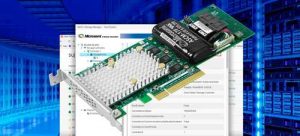Microchip/Microsemi: Switchtec PSX Gen3 PCIe Programmable Storage Switches
Jointly developed Open Data Center Committee solution from Tencent and Inspur flexibly pools compute, storage and networking resources
This is a Press Release edited by StorageNewsletter.com on March 20, 2019 at 2:17 pmMicrochip Technology Inc., via its Microsemi Corporation subsidiary, announced its Switchtec PSX Gen3 PCIe programmable storage switches have been included in a reference design from Tencent Technology Ltd., that has been posted to the web site of the Open Data Center Committee (ODCC), a consortium formed by China’s technology providers.
An ODCC co-sponsor, Tencent has based the reference design on its T-Flex architecture that uses the switches to pool NVMe storage, graphics processing units (GPUs), NICs and other resources, which improves configuration flexibility in performance I/O and storage designs and heterogeneous computing applications.
The T-Flex reference design featuring the Switchtec PCIe switch was jointly developed by Tencent and its partner Inspur Electronic Information Industry Co.,Ltd, a server supplier in China. T-Flex uses the Switchtec PSX Gen3 96-lane PCIe programmable storage switch to enable flexible, high-density designs that combine performance and efficiency with more agile delivery of diverse resources. By bringing scalable I/O resource pooling to NVMe SSDs, GPUs, NICs, and other PCI endpoints, the PSX PCIe switch enables a T-Flex system to deliver dynamic and flexible configurability while supporting different services with different hardware I/O performance requirements.
“Tier-1data center providers like Tencent are leveraging the capabilities that the Switchtec PCIe switches offer for enabling highly flexible compute and storage rack architectures,” said Andrew Dieckmann, VP, marketing and applications, data center solutions business unit, Microchip. “The publication of this reference design by ODCC will enable ODCC members to readily adopt this architecture and leverage the benefits of a composable infrastructure.“
“We’re excited to use the Switchtec PSX Gen3 PCIe programmable storage switch in the T-flex program,” said Herry Wang, manager, server department, Tencent. “It is a low-power solution that enables superior signal integrity, supports native x2 port bifurcation and provides a flexible programmable interface. Additionally, the Switchtec ChipLink diagnostic tool features advanced debug capabilities that aided and simplified overall system development.“
This is the second time the Switchtec Gen3 PCIe switch has been selected for an open reference design, in this case specifically for ODCC members. In 2017, the switch was incorporated into the Open Compute Project (OCP) Lightning (ST7200) reference design, which is also offered as a product by cloud-infrastructure provider Wiwynn Corp. for data center applications including enterprise storage systems, storage servers and ‘Rack Scale Architecture’ infrastructure. The switch enables a single-chip device in these applications to connect multiple PCIe NVMe SSDs while extending flexibility in the firmware to optimize the switch for specific application needs. The switch enables high-density, high-port-count systems with differentiating features such as the ability to customize functionality for cloud applications.
When used in a T-Flex IO resource pooling system, the Switchtec PSX Gen3 PCIe programmable storage switch enables connection of up to 16 host servers. Each host server can connect up to of four downstream T-Flex boxes and each of these T-Flex boxes can contain up to four GPU cards supporting AI computing. This means that one server can connect up to 16 GPU cards when connecting four T-Flex boxes.
The Tencent T-Flex reference design is posted to the Open Data Center Committee (ODCC) website, and available to ODCC members. Support is provided by Tencent and Inspur.
Read also:
Microsemi Unveils SmartROC 3200 and 2200 Storage Controllers
PCIe Gen 4 CPU interconnect, tri-mode media connectivity, supporting PCIe Gen 4 NVMe, 24Gb SAS, and 6Gb SATA on any lane, DirectPath architecture providing for low latency for NVMe transactions, and Dynamic Channel Multiplexing technology providing utilization of 24Gb SAS bandwidth
August 17, 2018 | Press Release















 Subscribe to our free daily newsletter
Subscribe to our free daily newsletter

